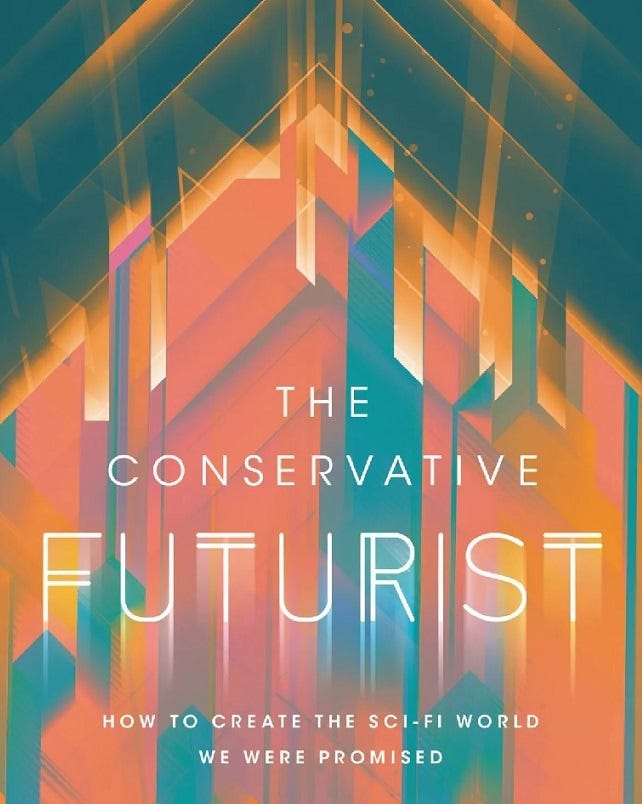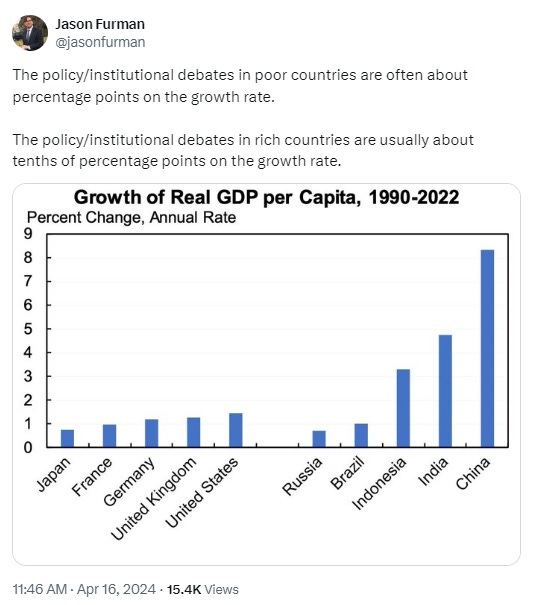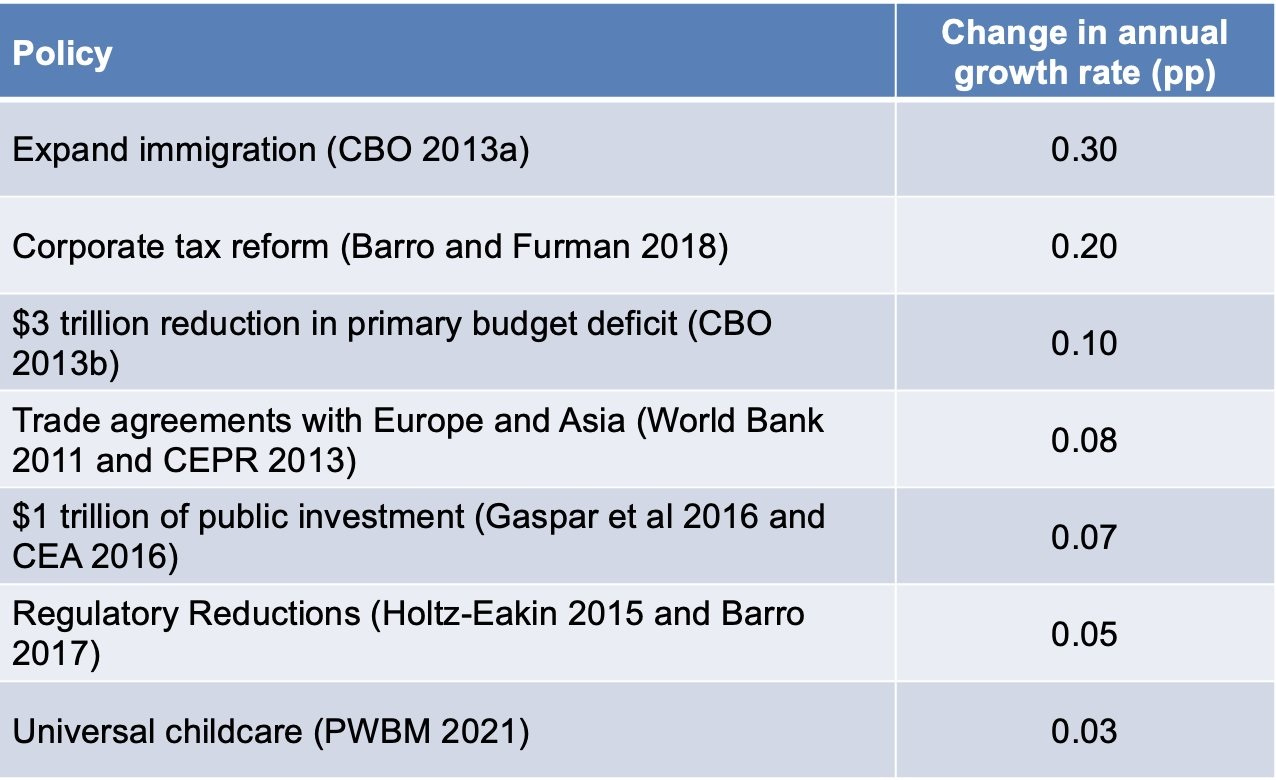⏩ We can do it! How our decisions can accelerate economic growth
Happy White Pill Wednesday #WhitePillWednesday ⤴
Quote of the Issue
“This is a story without end. All the world is still an America. The most promising words ever written on the maps of human knowledge are terra incognita—unknown territory.” - Daniel J. Boorstin, The Discoverers
The Conservative Futurist: How To Create the Sci-Fi World We Were Promised
"James Pethokoukis is one of the most enthusiastic and knowledgeable techno-optimists in the U.S. today. If anyone can show the conservative movement how to embrace the future, it's him." - Noah Smith, economist and publisher of the Noahpinion newsletter
The Essay
⏩ How our decisions can accelerate economic growth
Throughout The Conservative Futurist, I refer again and again to Herman Kahn, the 1960s nuclear war theorist who became a sunny futurist in the 1970s, as well as an evangelist for techno-capitalism. I love this Kahn quote, in particular, as an example of conservative futurist thinking: America would be OK, according to Kahn, as long as “we don’t have disastrously bad luck and we don’t do things that are incredibly dumb.”
In other words, our decisions do matter, though perhaps not as much as exogenous factors such as, say, an asteroid strike. Another example of luck (the good kind): Living at a time when a new technological wave emerges. If you’re a policymaker when a powerful tech boom kicks in, such as President Clinton in the 1990s, accept your good fortune — and probable reelection.
Here in the 2020s, an AI-driven boom that doubles US productivity growth for the rest of the decade would likely be more important than any single economic decision made by government. Even the worst policy ideas, such as trade protectionism and immigrant restrictions, might get papered over by oodles of unexpected growth. What a lucky break.
That said, even the best economic policy ideas typically don’t have massive effects on the economy, especially not one as big and complex as America’s. Here’s what Obama White House economic adviser Jason Furman recently X posted:
And to illustrate his point, Furman posted a slide from a Harvard economics class he teaches that gives estimates of the economic impacts various policies:
Lots of pro-growth policies can have an economic impact, but it takes a lot of them to have a big impact. Then again, when you’re dealing with a rich economy like America’s, boosting economic growth from 2.0 percent to 2.1 or 2.2 percent for a sustained period is hardly nothing. The cumulative growth effects really add up, as Furman goes on to explain:
Sometimes I feel like focusing on policies that only affect growth rates by a few tenths of a percentage point feels small. But then I remind myself that the difference between the United States and Argentina over the last 120 years was 0.5 percentage point.
Correct, 0.5 percentage point is a lot! And that’s one reason The Conservative Futurist advocates policies that would greatly boost R&D spending across the economy. In the book, I point to research from Benjamin F. Jones, a Northwestern University economist, that suggests that doubling US business and government R&D spending could generate ... wait for it … a 0.5 percentage point annual increase in productivity and real per-capita income growth rates over the long term.
Jones:
This would lead to enormous increases in standards of living over time. It would greatly advance the competitiveness of U.S. businesses and workers and the overall position of the U.S. economy in the world. And this economic orientation leaves out the health gains of longer and healthier lives, which are among the most valuable deliverables from the science and innovation system.
But wait, there’s more! Among other supergrowthy ideas in my book:
Improving the lowest-performing US teachers to just average — or replacing them with averages ones — could increase future economic growth by nearly a full percentage point.
Axing regulations that prioritize extreme safety precautions over allowing innovation, such as with nuclear power, could potentially add an additional percentage point of growth per year, which would significantly increase median household income from $75,000 to nearly $120,000.
Relaxed zoning and regulatory constraints in high-productivity cities New York, San Jose, and San Francisco could potentially increase US GDP by four percent and an additional $4,000 in average earnings for all American workers
Doubling the H-1B visa cap from 65,000 to 130,000 would raise the real GDP per capita growth rate by nine percent (not percentage points, unfortunately) in the long run.
Removing remaining trade barriers could increase US production by $450 billion to $600 billion annually, raising per capita income by $1500 to $2000 and household income by $4000 to $5300 annually.
Let’s return to AI. Still early days, and forecasts about the economic potential of large language models, especially, are speculative. Those caveats aside, the potential to upshift productivity growth from the 1.5 percent annual rate we’ve pretty much had since the early 1970s is awfully exciting.
Goldman Sachs forecasts the widespread adoption of generative AI could raise labor productivity growth in developed countries by 1.5 percentage points annually over a 10-year period. Accounting for overlap with current technology-driven gains, this would result in a 0.4 percentage point net increase in potential GDP growth. Economist Erik Brynjolfsson thinks productivity growth could be at least twice as fast as what the consensus currently thinks (more of the same 1.5 percent, more or less). Investment strategist Ed Yardeni sees productivity heading to 3.5 percent, or even 4.5 percent, by the end of the decade.
The potential to radically alter the growth trajectory of the American economy is why government should apply the Proactionary Principle: Do no harm to what appears to be a fundamental technological breakthrough. That’s another pro-growth, pro-progress idea.
But what hat will we decide? Bad AI policy might be one economic policy decision with a truly massive impact. We would be making our own bad luck — and plenty of it.
Micro Reads
▶ Business and Economics
The Global Turn Away from Free-Market Policies Worries Economists - NYT
Andreessen Horowitz raises $7.2bn and sets sights on AI start-ups - FT
Microsoft’s AI Copilot Is Starting to Automate the Coding Industry - Bberg
Tim Cook Says Apple Considers Making Gadgets in Indonesia in Pivot From China - Bberg
The man reinventing economics with chaos theory and complexity science - NS
▶ Policy
How One Author Pushed the Limits of AI Copyright - Wired
▶ AI
Can AI really change our material world? - FT
The Cloud Under the Sea - The Verge
▶ Health
Eli Lilly’s weight loss drug Zepbound shows promise as a sleep apnea treatment in late-stage trials - CNBC
Every year, tuberculosis kills over a million people. Can a new vaccine turn the tide? - Vox
▶ Clean Energy
Department of Energy Fusion Discovery Could Allow Physicists to Tame Volatile Plasmas - The Debrief
We Can’t Drill These Holes Fast Enough - Heatmap
Scientists make ‘major finding’ with nanodevices that can seemingly produce energy out of thin air: ‘Contradicting prior understanding’ - The Cool Down
▶ Space/Transportation
The great commercial takeover of low-Earth orbit - MIT Technology Review







